- Home
- Tom Clancy
Marine: A Guided Tour of a Marine Expeditionary Unit
Marine: A Guided Tour of a Marine Expeditionary Unit Read online
Table of Contents
Title Page
Copyright Page
Dedication
Acknowledgements
Foreword
Introduction
Marine 101: Ethos
Warrior Prince of the Corps: An Interview with General Charles Krulak
Transformation: Making Marines
Small Arms
Tools of the Trade
Getting There: The Gator Navy
A Guided Tour of the26th MEU (SOC)
Getting Ready: 26th MEU (SOC)training and operations
The MEU (SOC)in the Real World
Conclusion: A Corps for Five Hundred Years...
Bibliography
NOVELS BY TOM CLANCY
The Hunt for Red October
Red Storm Rising
Patriot Games
The Cardinal of the Kremlin
Clear and Present Danger
The Sum of All Fears
Without Remorse
Debt of Honor
Executive Orders
Rainbow Six
The Bear and the Dragon
Red Rabbit
The Teeth of the Tiger
SSN: Strategies of Submarine Warfare
NONFICTION
Submarine: A Guided Tour Inside a Nuclear Warship
Armored Cav: A Guided Tour of an Armored Cavalry Regiment
Fighter Wing: A Guided Tour of an Air Force Combat Wing
Marine: A Guided Tour of a Marine Expeditionary Unit
Airborne: A Guided Tour of an Airborne Task Force
Carrier: A Guided Tour of an Aircraft Carrier
Special Forces: A Guided Tour of U.S. Army Special Forces
Into the Storm: A Study in Command (written with General Fred Franks, Jr., Ret.)
Every Man a Tiger (written with General Charles Horner, Ret.)
Shadow Warriors: Inside the Special Forces
(written with General Carl Stiner, Ret., and Tony Koltz)
DISCLAIMER
The views and opinions expressed in this book are entirely those of
the author, and do not necessarily correspond with those of any corporation,
military service, or government organization of any country.
Most Berkley Books are available at special quantity discounts for bulk
purchases for sales promotions, premiums, fund-raising or educational use.
Special books, or book excerpts, can also be created to fit specific needs.
For information write to Special Markets at the address listed below.
MARINE
A Berkley Book / published by arrangement with
Jack Ryan Limited Partnership
Copyright (c) 1996 by Jack Ryan Limited Partnership.
All rights reserved.
This book, or parts thereof, may not be reproduced
in any form without permission.
For information address:
The Berkley Publishing Group, a division of Penguin Putnam Inc.,
375 Hudson Street, New York, New York 10014.
PRINTING HISTORY
Berkley trade paperback edition / November 1996
eISBN : 978-1-429-55505-0
BERKLEY(r)
Berkley Books are published by
The Berkley Publishing Group, a division of Penguin Putnam Inc.,
375 Hudson Street, New York, New York 10014.
BERKLEY and the "B" design are trademarks belonging to
Penguin Putnam Inc.
http://us.penguingroup.com
For Air Force Captain Scott O'Grady.
A downed and doomed "zoomie" whose faith in his God,
his country, his service, and himself,
along with the help of a few Marines, brought him
home to us. God bless him, and
the members of the 24th MEU (SOC)
who made us all proud to be Americans once again.
Acknowledgments
It is now time for the best part of book writing: thanking those who helped make it possible. We start with my longtime partner, researcher, and friend, John D. Gresham. Once again, he traveled across the landscape, from Fort Worth, Texas, to Rota, Spain, gathering the stories and digging out the facts that make this book special. Perhaps most important of all, he kept the promises to our partners in industry and the military, which are the things that make books like this possible. Again, we have also been given the gift of wisdom and experience from series editor Professor Martin H. Greenberg. Laura Alpher is again to be complimented for her wonderful portfolio of drawings, which have added so much to this book. Tony Koltz and Mike Markowitz also need to be recognized for their continuing support that was so critical and welcome. Thanks again goes to Cindi Woodrum, Diana Patin, and Roselind Greenberg for their support in backing us up as always.
A book like this would be impossible to produce without the support of senior service personnel in leadership positions, and this one is no exception. Our first thanks go to General Charles "Chuck" Krulak, the 31st Commandant of the Marine Corps. Thanks also to his hardworking PAO, Major Betsey Arends. Another group, less well known but equally important, that was vital to our efforts consisted of the members of the various USMC public affairs offices (PAOs) and protocol organizations that handled our numerous requests for visits and information. Tops on our list were Brigadier General Terry Murray, Lieutenant Colonel Patricia Messer, and Lieutenant Mike Neuman of the Headquarters PAO. Along with them, Major General Paul Wilkerson, Captain Whitney Mason, Lieutenant Scott Gordon, and many others worked hard to get their stories across. Down at Quantico, Colonel Mick Nance and Gunner Bill Wright made our visits both memorable and livable in the incredible heat of 1995. At NAVSEA, Captain George Brown, Barbara A. Jyachosky, Sue Fili, Captain Manrin Gauthier, Captain Stan Harris, Colonel Al DeSantis, George Pickins, Paul Smith, and Gene Shoults told the shipping story. Over at the intelligence agencies, once again there was Jeff Harris and Major Pat Wilkerson at NRO, Russ Eggnor's photo shop at CHINFO, Lieutenant Colonel Jim Vosler and Penny Chesnut at DMA, and Dwight Williams at DARO. Many other helpful Marines studded the landscape to pass on their wisdom to us. Thanks to you all.
It is out at the units that you get the real story, though, and this year was a treasure chest of experiences and new friends. At the 26th MEU (SOC), there was the incredible Colonel Jim Battaglini, who is a national asset, along with such memorable personalities as Colonel "Fletch" Fergeson, Sergeant Major Bill Creech, Gunny Sergeant Tim Schearer, and Major Dennis Arnellio. Over at BLT 2/6, there was Lieutenant Colonel John Allen, an officer and Virginia gentleman. HMM-264 was led by the crusty and wise Lieutenant Colonel "Peso" Kerrick, and MSSG-26 by the capable Lieutenant Colonel Donald K. Cooper. Thanks also to Brigadier General Marty Berndt and Lieutenant Colonel Chris Gunter for sharing their adventures from 1995. And for all the other Marines at all the bases, we say, "Oohrah!" and many thanks for guarding the walls of freedom.
Out in the fleet, there were many wonderful folks as well. Special thanks to Captain C. C. Buchanan, who made PHIBRON 4 a great place to work and learn. Captains Ray Duffey and Stan Greenawalt as well as their incredible crew made USS Wasp our home-away-from-home. Captain John M. Carter of USS Shreveport and Commander T. E. McKnight of USS Whidbey Island are to be thanked as well for letting us break bread and share time with them and their crews. And out in the Med, Commander Mike John, Lieutenant Commander Bill Fennick, Ensign Dan Hetledge, and many others made our trip to Spain special.
Again, thanks are due to our various industrial partners, without whom all the information on the various aircraft, weapons, and syste
ms would never have come to light. At the aircraft manufacturers there was Barbara Anderson, Robert Linder, Lon Nordeen, Gary Hakinson, Mary Ann Brett, and David Wessing of McDonnell Douglas; Joe Stout, Karen Hagar, Jeff Rhodes, James Higginbotham, and Doug McCurrah of Lockheed Martin; Russ Rummnay, Pat Rever, and Paige Eaton at Bell Textron; and finally, Bill Tuttle and Foster Morgan of Sikorsky. We also made and renewed many friendships at the various missile, armament, and system manufacturers including: the incomparable Vicki Fendlason and Tony Geishanuser at Texas Instruments; Larry Ernst at General Atomics; Glenn Hillen, Bill West, Kearny Bothwell, and Cheryl Wiencek at Hughes; Tommy Wilson, Adrien Poirier, Edward Ludford, Dave McClain, and Dennis Hughes at Loral; Eric O'Berg and William D. Eves at Delco; Jim Mclngvale, Steve Davis, and many others at Litton Ingalls; Karl G. Oskoian at General Dynamics; Madeleine Orr Geiser and Bill Highlander at United Defense; Lee Westfield and Ms. Kathleen Louder at Right Away Foods; Rhonda Restau at Oregon Freeze Dry; Paige Sutkamp at the Wornick Company; Russ Logan at Beretta; Art Dalton and Brian Berger at Colt; Ronney Barrett at Barrett Firearms, and, last but certainly not least, Ed Rodemsky of Trimble, who again kept us up to date on the GPS system.
Again, we give thanks for all of our help in New York, especially Robert Gottlieb, Debra Goldstein, and Matt Bialer at William Morris. At Berkley Books, our appreciation again goes out to our editor, John Talbot, as well as David Shanks, Patti Benford, and Kim Waltemyer. For retiring friends like Jim Myatt and Robin Higgins, thanks for all you did and gave to the Corps and the country. Thanks also to our press pals, including Gidget Fuentes, Lisa Burgess, and Chris Plant. And for all the folks who took us on adventures, thanks for teaching the ignorant how things work for real. For our friends and loved ones, we have to once again thank you. For being there when we can't. God's blessings and goodwill upon you all.
Foreword
On January 5th, 1991, a third night of fitful sleep gave way to another day of incredibly tense living for U.S. Ambassador Bishop and the 281 personnel trapped with him in Somalia's capital city of Mogadishu. Included were officials from thirty nations, 12 diplomatic heads of mission, and 39 Soviets. After a message for help and two aborted rescue attempts by other nations, those remaining in the war-torn country, uncertain of their future, joined ranks and hunkered down inside the besieged and soon-to-be-overrun American Embassy compound.
Aboard the USS Trenton (LPD-14), 466 nautical miles away, two CH-53E Super Stallion helicopters with forty-six Marines and 9 Navy SEALs lifted off the flight deck into the Arabian night. Their mission--to evacuate the American Embassy in Mogadishu. After flying for seventeen hours, and two midair refuelings, the helos flew over the unsuspecting city at a twenty-five-foot altitude and landed in the compound at 0710--just as the rebels were scaling the walls. Within minutes Marines had secured the embassy. Shortly thereafter, the two helicopters departed with the first 61 evacuees. Less than twenty-four hours later, all 281 personnel had been successfully evacuated. The Amphibious Readiness Group with its embarked Marine Expeditionary Unit (Special Operations Capable)--ARG/MEU (SOC)--welcomed back its tired but successful warriors and quietly steamed back over the horizon.
Four years later and four seas away, a fatigued Air Force captain entered the sixth day of his fight for survival in rugged northern Bosnia. At home, a nation awaited news of her first native son shot down while supporting United Nations and NATO operations in this conflict. Out of sight, eighty-seven nautical miles away aboard the USS Kearsarge (LHD-3), another MEU (SOC) launched its Tactical Rescue of Aircraft and Personnel (TRAP) force. In the pre-dawn darkness of June 8th, 1995, with less than a two-hour notice, forty-three Marines boarded two helicopters and launched into the Adriatic dawn. Joined by Cobra helicopter gunships and Harrier jump jets, they flew east over the missile-infested mountain to recover a tired, but relieved, Captain Scott O'Grady from the grasp of the pursuing Serbs.
Within twenty-four hours the rescued pilot was en route back to his home station at Aviono, and ultimately to the White House. Back aboard ship, the Marines cleaned their weapons and maintained their helicopters and equipment. They then rested as the ships sailed quietly over the horizon toward another readiness training exercise, all part of their scheduled 180-day tour of duty afloat. In both of these sagas, the individual of the hour was the United States Marine. For over 220 years, Marines have served at the end of America's operational reach--on freedom's far frontiers. These Marines are the backbone of the ARG/MEU (SOC) team, our regional commanders' force of choice for both forward presence and crisis response. When American interests are threatened abroad, Marines are on scene answering the call.
Marines and MEU (SOC)s are not special operations forces. They are general purpose forces who have successfully completed several months of intense specialized training, education and evaluation. Then they deploy forward with ARGs at their country's bidding--often in harm's way. They are America's warrior class: there when needed and prepared to "do what must be done." They seek only to serve their nation, and they enjoy the strong camaraderie born of shared sacrifice and hardship.
Marines have been doing this with rare consistency and success for more than 220 years. Since their inception in November 1775, when our Founding Fathers "...resolved, that two Battalions of Marines be raised...[and]...that particular care be taken that no person be appointed or enlisted into said Battalions, but such as are good seamen or so acquainted with maritime affairs as are able to serve to advantage by sea," Marines have continually demonstrated their readiness and utility. On their inaugural amphibious raid in the Caribbean in March 1776, Marines captured British cannon and powder to support the Continental Army. Since then they have been our nation's premier naval expeditionary warfighters, ever capable of executing a wide range of crucial missions "from the sea." On numerous occasions the Navy/Marine team has responded quickly and successfully to Presidential, Congressional, or military orders with such wide latitudes as "attack, take, and destroy as you may find," "perform duties as may be directed," or "render appropriate assistance." A 220-year legacy of readiness, teamwork, and courage is the result. Generations of Marines have repeatedly proven the veracity of both the Marine Corps motto of "Semper Fidelis" ("Always Faithful") and the reputation earned at Iwo Jima, where "uncommon valor was a common virtue."
Beginning with the "Banana Wars" in Haiti, Santo Domingo, and Nicaragua in the 1920s and 1930s, the Marine Corps bred a new generation of lean, battle-hardened fighters who were as proficient at amphibious landings and long-range jungle patrols as they were at urban warfare and quelling civil disturbances. Their stock-in-trade was readiness, versatility, and a deadly earnestness in fulfilling any assigned mission. These Marines got there fast, and with surprise, and came from the sea. They traveled light, fought hard, and lasted long. This reputation was not lost on either actual or potential adversaries. From these "interwar" experiences came the doctrine and training that would propel the Marine Corps for over forty years. The 1933 Tentative Manual for Landing Operations and the 1939 Small Wars Manual were the result. With the evolution of these operational practices in places like China and the Caribbean came the concept that the United States Marine Corps played a unique role in America's national defense. Besides being amphibious, Marines emerged as America's premier force-in-readiness.
As World War II dawned and our Corps grew by over fivefold, the legacy of ready and versatile soldiers of the sea was emblazoned on yet another age of American youth. Lieutenant Colonel Merritt "Red Mike" Edson's 1st Raider Battalion conducted its August 7th, 1942, landing on Tulagi with Marines steeped in this training and tradition. So too did the 1st Parachute Battalion that same day on Gavutu. Lieutenant Colonel Evans Carlson's 2nd Raider Battalion raided Makin Island a day later with Marines forged in the same fire. Each of these new units harnessed the raw energy of "basic Marine," and emboldened them with special and focused training, unit cohesion, and clarity of purpose. These units were special only because they consisted of special warriors:
Marines capable of and willing to achieve extraordinary tasks because they had unquestioning confidence in themselves, their leaders, and their training.
These hard-earned lessons of the mid-20th century sustained Marine Corps training through Vietnam and well into the 1970s. With a prolonged investment in jungle and counter-guerrilla warfare as well as mountain and arctic warfare, the Marine Corps gradually refined a growing body of special operations capabilities. This included helicopter-borne reinforcement operations like "Sparrow Hawk" and "Bald Eagle," amphibious and riverine raids, snipers and discriminate shooters, and non-combatant evacuation operations (NEO) and TRAPs. What may have been missing in doctrinal cohesion was more than made up for with battle-tested tactical proficiency and well-honed operational procedures. Regardless of whether conducting long-range deep reconnaissance patrols or direct action missions like sniping, Marines had a well-earned reputation as fighters with courage, savvy, and skill.
After Vietnam, the U.S. military refocused on the Cold War, and the Marine Corps returned to its historic role as the nation's amphibious force-in-readiness. In the Pacific, Marines evacuated Saigon and Phnom Penh, boarded the Mayaguez, and rescued hurricane victims. From the Caribbean to the Mediterranean, Marine Amphibious Units (MAUs) executed NEOs and peacekeeping operations in Cyprus, Grenada, and Beirut. Around the globe, MAUs planned for and rehearsed countless other contingencies. From 1983 through early 1985, these lessons were codified with the activation of the new Marine Amphibious Unit/Special Operations Capable--MAU (SOC). This two-thousand-Marine unit was built around a Marine infantry Battalion Landing Team (BLT) as the Ground Combat Element (GCE), a composite helicopter squadron as the Aviation Combat Element (ACE), and a MAU Service Support Group (MSSG) as Combat Service Support Element (CSSE). This triad, along with the parent MAU Command Element (CE), represented the "pointy end of the spear" in America's foreign policy.

 Changing of the Guard
Changing of the Guard Clear and Present Danger
Clear and Present Danger Hounds of Rome
Hounds of Rome Breaking Point
Breaking Point Tom Clancy's Jack Ryan Books 7-12
Tom Clancy's Jack Ryan Books 7-12 Full Force and Effect
Full Force and Effect The Archimedes Effect
The Archimedes Effect Combat Ops
Combat Ops Into the Storm: On the Ground in Iraq
Into the Storm: On the Ground in Iraq Under Fire
Under Fire Point of Impact
Point of Impact Red Rabbit
Red Rabbit Rainbow Six
Rainbow Six The Hunt for Red October
The Hunt for Red October The Teeth of the Tiger
The Teeth of the Tiger Conviction (2009)
Conviction (2009) Battle Ready
Battle Ready Patriot Games
Patriot Games The Sum of All Fears
The Sum of All Fears Fallout (2007)
Fallout (2007) Red Storm Rising
Red Storm Rising The Cardinal of the Kremlin
The Cardinal of the Kremlin Executive Orders
Executive Orders Lincoln, the unknown
Lincoln, the unknown Threat Vector
Threat Vector The Hunted
The Hunted Shadow Warriors: Inside the Special Forces
Shadow Warriors: Inside the Special Forces End Game
End Game Special Forces: A Guided Tour of U.S. Army Special Forces
Special Forces: A Guided Tour of U.S. Army Special Forces Locked On
Locked On Line of Sight
Line of Sight Tom Clancy Enemy Contact - Mike Maden
Tom Clancy Enemy Contact - Mike Maden Fighter Wing: A Guided Tour of an Air Force Combat Wing
Fighter Wing: A Guided Tour of an Air Force Combat Wing Springboard
Springboard Line of Sight - Mike Maden
Line of Sight - Mike Maden EndWar
EndWar Dead or Alive
Dead or Alive Tom Clancy Support and Defend
Tom Clancy Support and Defend Checkmate
Checkmate Command Authority
Command Authority Carrier: A Guided Tour of an Aircraft Carrier
Carrier: A Guided Tour of an Aircraft Carrier Blacklist Aftermath
Blacklist Aftermath Marine: A Guided Tour of a Marine Expeditionary Unit
Marine: A Guided Tour of a Marine Expeditionary Unit Commander-In-Chief
Commander-In-Chief Armored Cav: A Guided Tour of an Armored Cavalry Regiment
Armored Cav: A Guided Tour of an Armored Cavalry Regiment Tom Clancy's Jack Ryan Books 1-6
Tom Clancy's Jack Ryan Books 1-6 The Ultimate Escape
The Ultimate Escape Airborne: A Guided Tour of an Airborne Task Force
Airborne: A Guided Tour of an Airborne Task Force Debt of Honor
Debt of Honor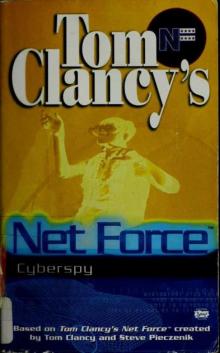 Cyberspy
Cyberspy Point of Contact
Point of Contact Operation Barracuda (2005)
Operation Barracuda (2005) Choke Point
Choke Point Power and Empire
Power and Empire Every Man a Tiger: The Gulf War Air Campaign
Every Man a Tiger: The Gulf War Air Campaign Endgame (1998)
Endgame (1998) EndWar: The Missing
EndWar: The Missing Splinter Cell (2004)
Splinter Cell (2004) The Great Race
The Great Race True Faith and Allegiance
True Faith and Allegiance Deathworld
Deathworld Ghost Recon (2008)
Ghost Recon (2008) Duel Identity
Duel Identity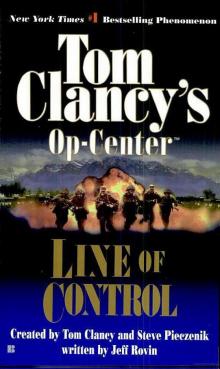 Line of Control o-8
Line of Control o-8 The Hunt for Red October jr-3
The Hunt for Red October jr-3 Hidden Agendas nf-2
Hidden Agendas nf-2 Acts of War oc-4
Acts of War oc-4 Ruthless.Com pp-2
Ruthless.Com pp-2 Night Moves
Night Moves The Hounds of Rome - Mystery of a Fugitive Priest
The Hounds of Rome - Mystery of a Fugitive Priest Into the Storm: On the Ground in Iraq sic-1
Into the Storm: On the Ground in Iraq sic-1 Threat Vector jrj-4
Threat Vector jrj-4 Combat Ops gr-2
Combat Ops gr-2 Virtual Vandals nfe-1
Virtual Vandals nfe-1 Runaways nfe-16
Runaways nfe-16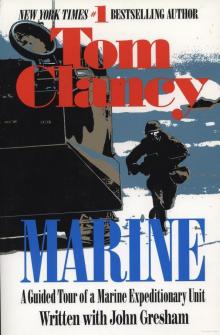 Marine: A Guided Tour of a Marine Expeditionary Unit tcml-4
Marine: A Guided Tour of a Marine Expeditionary Unit tcml-4 Shadow Warriors: Inside the Special Forces sic-3
Shadow Warriors: Inside the Special Forces sic-3 Jack Ryan Books 1-6
Jack Ryan Books 1-6 Cold Case nfe-15
Cold Case nfe-15 Changing of the Guard nf-8
Changing of the Guard nf-8 Splinter Cell sc-1
Splinter Cell sc-1 Battle Ready sic-4
Battle Ready sic-4 The Bear and the Dragon jrao-11
The Bear and the Dragon jrao-11 Fighter Wing: A Guided Tour of an Air Force Combat Wing tcml-3
Fighter Wing: A Guided Tour of an Air Force Combat Wing tcml-3 Patriot Games jr-1
Patriot Games jr-1 Jack Ryan Books 7-12
Jack Ryan Books 7-12 Mission of Honor o-9
Mission of Honor o-9 Private Lives nfe-9
Private Lives nfe-9 Operation Barracuda sc-2
Operation Barracuda sc-2 Cold War pp-5
Cold War pp-5 Point of Impact nf-5
Point of Impact nf-5 Red Rabbit jr-9
Red Rabbit jr-9 The Deadliest Game nfe-2
The Deadliest Game nfe-2 Springboard nf-9
Springboard nf-9 Safe House nfe-10
Safe House nfe-10 EndWar e-1
EndWar e-1 Duel Identity nfe-12
Duel Identity nfe-12 Deathworld nfe-13
Deathworld nfe-13 Politika pp-1
Politika pp-1 Rainbow Six jr-9
Rainbow Six jr-9 Tom Clancy's Power Plays 1 - 4
Tom Clancy's Power Plays 1 - 4 Endgame sc-6
Endgame sc-6 Executive Orders jr-7
Executive Orders jr-7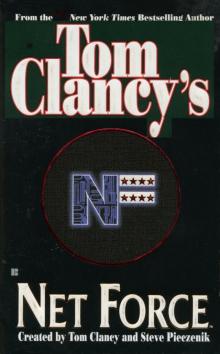 Net Force nf-1
Net Force nf-1 Call to Treason o-11
Call to Treason o-11 Locked On jrj-3
Locked On jrj-3 Against All Enemies
Against All Enemies The Sum of All Fears jr-7
The Sum of All Fears jr-7 Sea of Fire o-10
Sea of Fire o-10 Fallout sc-4
Fallout sc-4 Balance of Power o-5
Balance of Power o-5 Shadow Watch pp-3
Shadow Watch pp-3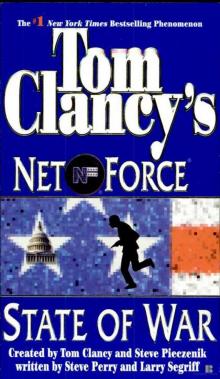 State of War nf-7
State of War nf-7 Wild Card pp-8
Wild Card pp-8 Games of State o-3
Games of State o-3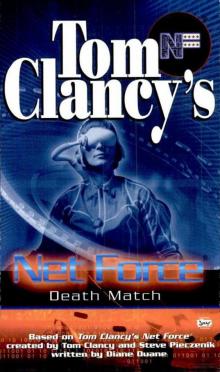 Death Match nfe-18
Death Match nfe-18 Against All Enemies mm-1
Against All Enemies mm-1 Every Man a Tiger: The Gulf War Air Campaign sic-2
Every Man a Tiger: The Gulf War Air Campaign sic-2 Cybernation nf-6
Cybernation nf-6 Support and Defend
Support and Defend Night Moves nf-3
Night Moves nf-3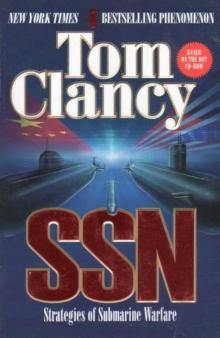 SSN
SSN Cutting Edge pp-6
Cutting Edge pp-6 The Cardinal of the Kremlin jrao-5
The Cardinal of the Kremlin jrao-5 War of Eagles o-12
War of Eagles o-12 Op-Center o-1
Op-Center o-1 Mirror Image o-2
Mirror Image o-2 The Archimedes Effect nf-10
The Archimedes Effect nf-10 Teeth of the Tiger jrj-1
Teeth of the Tiger jrj-1 Bio-Strike pp-4
Bio-Strike pp-4 State of Siege o-6
State of Siege o-6 Debt of Honor jr-6
Debt of Honor jr-6 Zero Hour pp-7
Zero Hour pp-7 Ghost Recon gr-1
Ghost Recon gr-1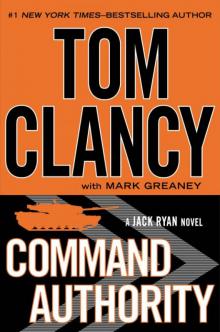 Command Authority jr-10
Command Authority jr-10 Tom Clancy's Power Plays 5 - 8
Tom Clancy's Power Plays 5 - 8 Checkmate sc-3
Checkmate sc-3 Breaking Point nf-4
Breaking Point nf-4 Gameprey nfe-11
Gameprey nfe-11 The Hunted e-2
The Hunted e-2 Hidden Agendas
Hidden Agendas Divide and Conquer o-7
Divide and Conquer o-7